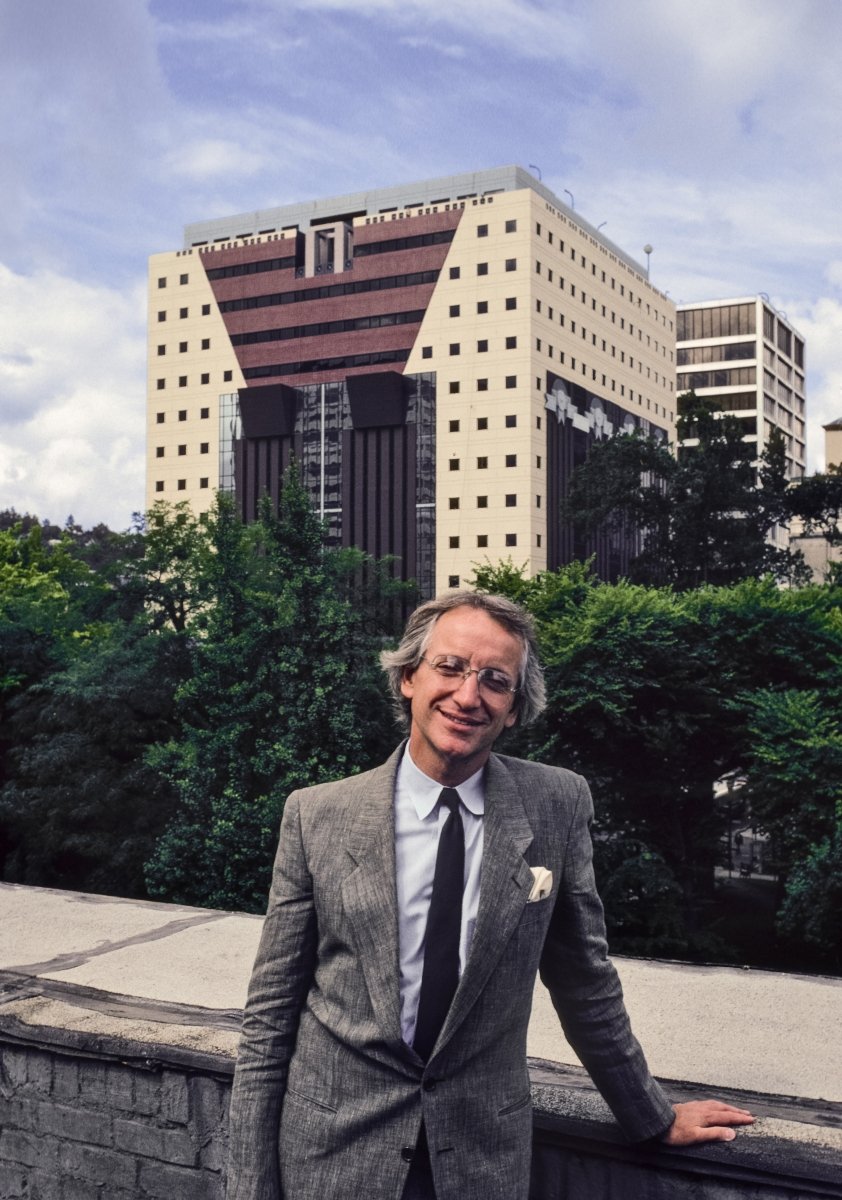
May 19, 2015
Remembering Michael Graves: Friends, Colleagues, and Collaborators Pay Tribute
Cherished friends, colleagues, and collaborators remember the multifaceted personality and contemplate the architect’s legacy.

A coy Michael Graves, not yet 50, poses in front of the Portland Building in 1982, just after the project’s completion. Revisiting the building last fall, Graves recalled the “uplifting” experience to an audience: “I had the biggest smile on my face. It was joy.”
Courtesy ©1982 Peter Aaron/Otto Archive
Upon Michael Graves’ passing in March, critics and commentators were quick to submit their favorite version of the architect-designer for dutiful tribute. These conflicting accounts varied in their degrees of generosity, but nevertheless gelled into a singular narrative. The young turk from Princeton (actually, Indiana) and artiest member of the New York Five was pitted against the indulgent Mannerist, then tragically deposed Postmodern father—only to be later redeemed by the thousands of products he designed for popular consumption.
Such neat polarizations aside, the man was far more complicated and talented than such portrayals will allow. Graves the great architect could be intimate and monumental, iconoclastic and reverential, challenging and coddling—often all in the same building. The designer Graves, who bridged the taste gap between Milan and Missouri, was playful, almost impishly so. Chummy but constructive was Professor Graves, who, for more than four decades, ushered students through their architectural educations.
Here, cherished friends, colleagues, and collaborators remember the many persons of Michael Graves and contemplate his rich legacy.

A period photograph shows Peter Eisenman (bottom row, with pointing stick) and Michael Graves (seated to Eisenman’s left) conducting a studio crit at Princeton. Peter Waldman is seated to the far right.
Courtesy Princeton School of Architecture Archives
Michael was always generous, and he always did drawings for me for birthdays, Christmas, or work anniversaries. He was my great teacher, as he was to many who were in his early classes. In his teaching, there was no division between the utility or inspiration of the past and the most avant-garde work we thought we were doing. It was all about an architectural continuity.
After I graduated in 1967 and went off to join the Peace Corps in Peru for two years, I returned to Princeton to work with Michael in his small office, what was really just a janitor’s apartment above a great bank in a Dutch revival building from 1892. It was just the two of us—we worked at a long, thin table in a compact garret room that was both the entry and conference room. On my first day of work, he expected me to make coffee, and I didn’t know how to use the coffee maker—I was never much of a coffee drinker. I don’t know if he was disappointed!
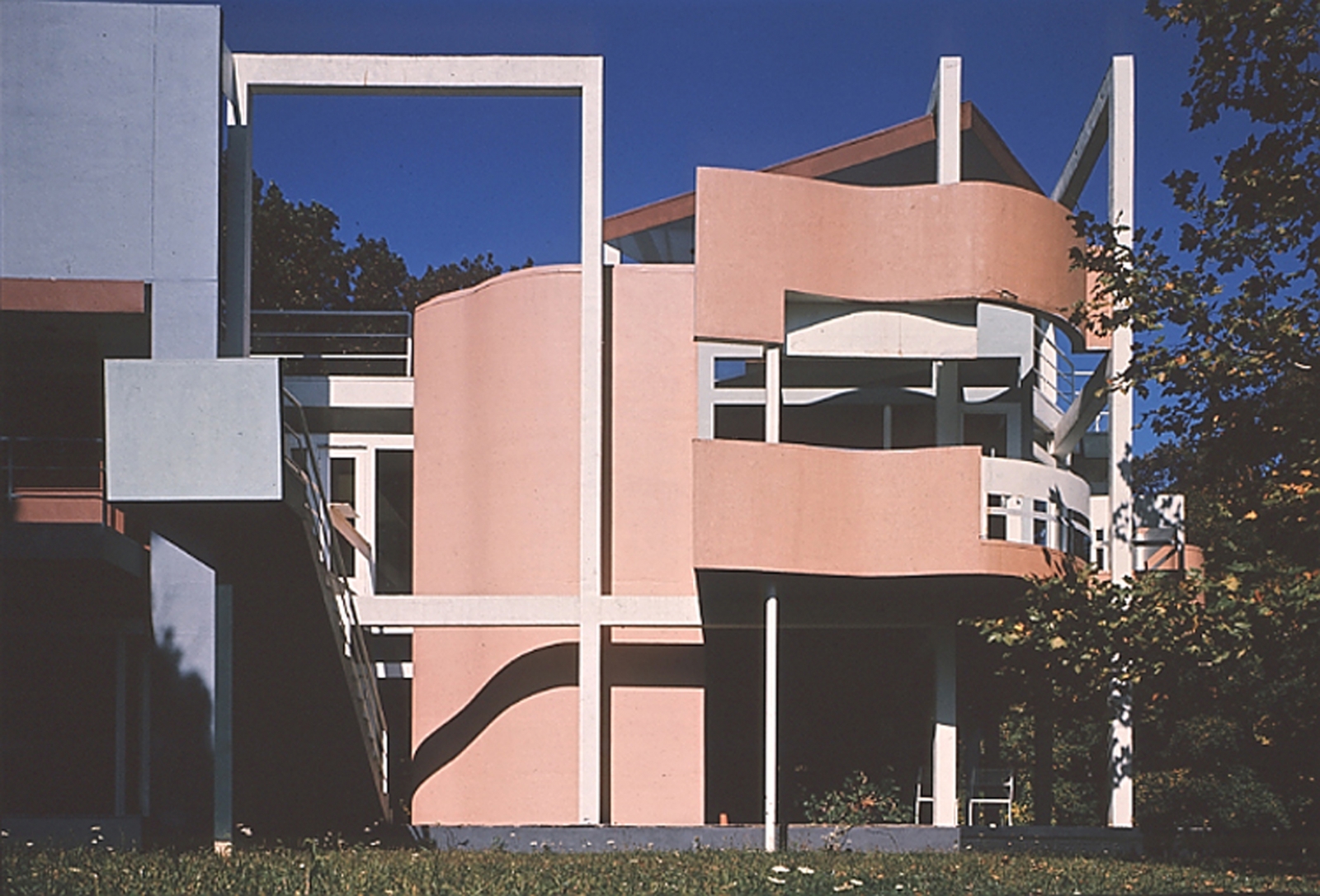
The Snyderman House (1972) represented the height of Graves’ “White” period and the limits of his idiosyncratic, neo-Corbusian architectural vocabulary.
Courtesy Michael Graves Architecture & Design
I remember, in 1970, when we were doing the Alexander House project—an addition to a wonderful 1750s stone house we designed a two-story addition for. (Some called it a Cubist Kitchen pretending to be a Garden Facade.) as we worked, he asked me things like, “Peter, on a Sunday morning when you’re about to read the New York Times, what kind of light would you want where you’re reading?” and I answered, “Well, if I start at sunrise, I might not put it down until noon.” So he said, “We’ll make sure you have light coming in the morning from sunrise to noon all year.” Michael was sophisticated in art, literature, and history, but he always brought these interests back to everyday life. Everything he touched—whether in his work, home, or office—was composed with a sense of life.
Peter Waldman is an architect and professor at the University of Virginia. He was among Michael Graves’ first students at Princeton in 1963 and, later, one of his first employees.

The Benacerraf house (1969) initiated Graves’ string of “Cubist kitchen” additions in Princeton.
Courtesy Michael Graves Architecture & Design
Michael Graves was an architect of exceptional talent. He was one of the first figures I met when I came to the Princeton School of Architecture as a visiting professor in the mid-1960s. Later, I would have the opportunity of recommending him for one of his earliest domestic commissions, the Benacerraf House (1969) in Princeton. This was Graves during his neo-Corbusian period, when the concept of layered space in the Cubistic sense came to the fore. This idea, as theoretically elaborated by Bernard Hoesli, Colin Rowe, and Robert Slutsky, was very influential on the young architects of the East Coast, above all, on the work of the so-called Five Architects of New York, of which Graves was a prominent member. Together with the Hanselmann House in Fort Wayne, Indiana (1967), the two houses were Graves’ contribution to an informal early showing of the Five Architects exhibition staged in the Museum of Modern Art at the end of the decade.
One of the most interesting things about the Hanselmann House, in particular, was the tension between the layered spatial frontality of the cubic form and subsequent volumetric rotation, largely due to a stream running diagonally across the site to the southeast of the building. The square plan of the first floor finds itself in opposition to both the L-shape plan of the children’s bedrooms-plus-playroom on the ground floor and the L-shaped parents’ bedroom on the top floor. This play between the frontal and the diagonal, between the square and the rotated square of the terrace at grade, was echoed by the window openings, and by Graves’ abstractly picturesque mural at the back of the living volume, in part neo-Purist and in part Wilhelm de Kooning.
This was Graves at the height of his powers as an architect/painter, and this same figure will proceed to project a more generous, grandiose version of a similar thematic in a house for the Rockefellers in the Pocantico Hills, New York (1969).
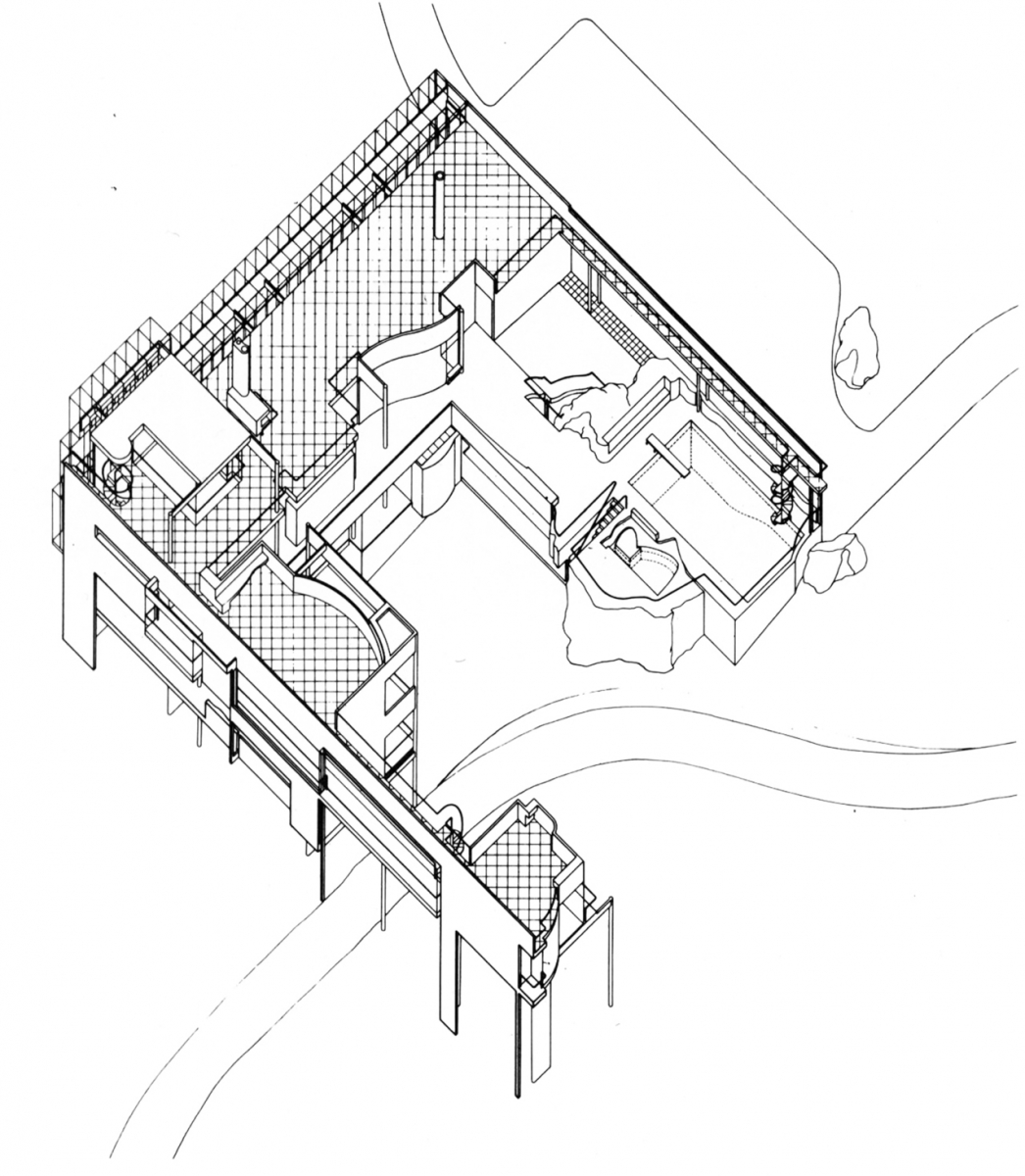
The design for the Rockefeller House (1969) found Graves investigating formal ideas of architectural transparency and layering.
Courtesy Michael Graves Architecture & Design
These works were possibly more sensitively functional and subtly inflected than the contemporaneous designs of either Peter Eisenman or John Hejduk, or even, for that matter, Richard Meier and Charles Gwathmey. However, thereafter Graves’ work will never recover, in my view, from his gratuitous swerve into a scenographic monumentality that first emerged with the Plocek House and the unbuilt, Ledoux-like Fargo-Moorhead Cultural Center Bridge (both 1977), and which figured into the subsequent design of a decorative office building for Portland, along with the mythical reclining figure of Portlandia gracing its front. Graves’ talent will somehow enter a never-never land of decorative sheds; a neo-Art Deco civic manner asserted in the face of a suburban megalopolis without any boundaries—a there, in fact, that is no longer there.
Kenneth Frampton is the Ware professor of architecture at Columbia University’s Graduate School of Architecture, Planning and Preservation. He was a member of the Conference of Architects for the Study of the Environment (CASE), which was founded in 1964 by Peter Eisenman and in whose ranks could be counted several practicing architects, including Richard Meier, Robert Venturi, and Graves.
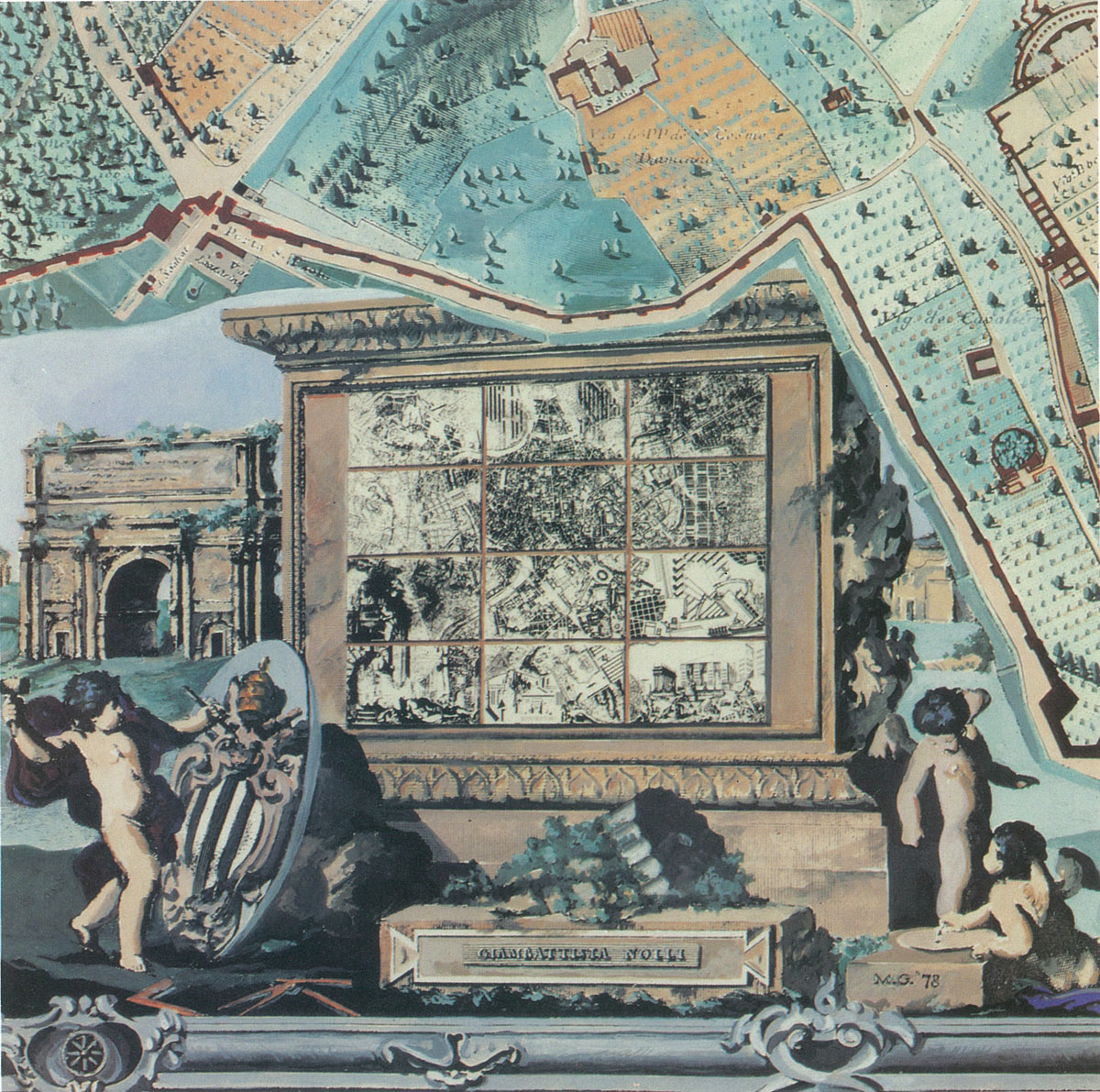
Graves’ cover design of a special AD monograph devoted to the Roma Interrotta exhibition (1978). Graves edited the issue and contributed an introductory essay, which was paired with a review of the show by the architect Alan Chimacoff, Graves’ then-colleague at Princeton.
Courtesy Michael Graves Architecture & Design
When I arrived at Princeton in 1973, the school of architecture was a place of great vitality. The “Golden Age” of Jean Labatut had faded, and the first era of true modernity within the school had been established, beginning with the arrival of Michael Graves, Peter Eisenman, Kenneth Frampton, Anthony Vidler, and Robert Geddes as dean—all in the 1960s. But by the next decade, the school was already in transition as Eisenman and Frampton had moved to New York. The intellectual core of Princeton—a small school with only 50 to 60 graduate students—were Michael Graves and Tony Vidler, along with Thomas Schumacher, Harrison Fraker, and Peter Waldman in youthful support. There were also healthy ties to Cornell and England via Colin Rowe and Alan Colquhoun. With deep traditions tying history, theory, and design together intimately, the school was strong professionally, and the waning social awareness of the 1960s was giving way to a resurgence of emphasis on the discipline of architecture.
Michael was the force at Princeton. His thoughts were evident everywhere in the school’s studios and classrooms. His architecture was changing in captivating ways, moving from an abstract, ornate Corbusian Modernism to an inventive, landscape‐engaging embrace of “pre‐modern,” traditional planning strategies, and to the formal and expressive characteristics of his mature work—that belonging to the era of Postmodernism. Increasingly widely published, this work gained national awareness.
Though highly personal in his views and motivations, Michael’s willingness to engage in broad architectural discussion at a high level—irrespective of any “party line”—was an extraordinary gift to the school. That climate surprised national and international visitors who often arrived expecting to find the “Michael Graves Institute,” only to discover open, challenging discourse. It was a perfect place for young faculty to nurture personal ideas and grow to their own maturity.
Most important, as a teacher, Michael left an imprint of intellectual challenge and understanding in the minds of all students who crossed his path—encouraging lifelong thought and introspection, regardless of belief. Today’s winds of fashion blow unpredictably as journalists’ determinations of architectural quality seem largely based on novelty and huge cantilevers, without much concern for responsible urbanism. Assessments are cursory at best, and oftimes based in limited knowledge of architecture. In this setting it is impossible to speculate on Michael Graves’s importance in history. But, I am hopeful that the pendulum will eventually swing to thoughtful explorations that reveal the depth of understanding in his work—of architecture at its roots, of an uncanny gift for cross‐cultural interpretations of architectural form, and of a humanistic urbanism—and the importance of these values in our world.
Alan Chimacoff was, until recently, an adjunct faculty member at the Princeton University School of Architecture. He and Graves were both professors at the school from 1973–1988.
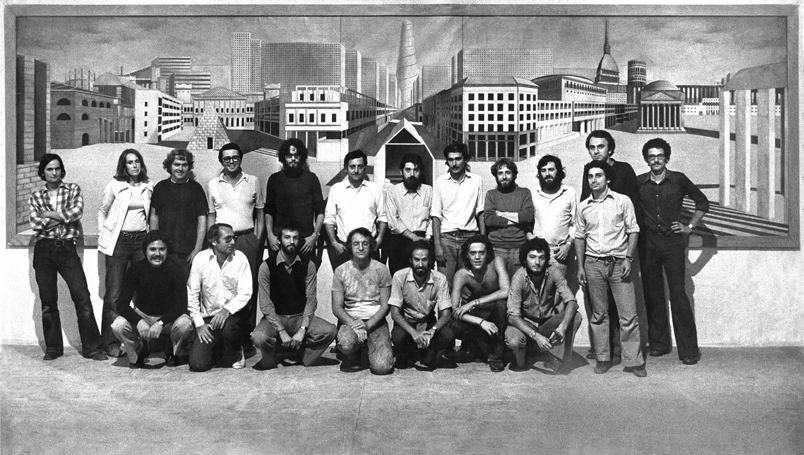
Participating architects at the XV Milan Triennale (1973), whose theme, “Architettura Razionale,” was chosen by the Italian architect Aldo Rossi (center left, rear aisle). The event catapulted the Italian neo-avant-garde, collectively termed the Tendenza, into the broader architectural discourse. The group, seen here standing in front of Arduino Cantafora La Città Analoga collage, invited the members of the loosely formed New York Five to exhibit alongside them. Of the “Five,” only Graves (center left, front aisle) and Richard Meier (second from left, front aisle) are pictured here.
Courtesy Heinrich Helfenstein, Zurich
In 1977 I was invited to Princeton to replace Tony Vidler, but Michael Graves insisted that he and I teach together. I replied that I would “rather stay friends,” because the Princeton School of Architecture was a “Michael Graves school,” in which everyone―both his friends and his enemies―lingered two years behind his stylistic evolutions. Graves and Eisenman had taken Rowe and Slutzky’s “Transparency: Part II” literally, to poetical extremes. Michael was doing neoclassical experiments close to my own, but at the time they were not yet released for general imitation.
I gave my students a project on the urbanism of Le Corbusier’s Mundaneum project in Geneva, but Michael didn’t warm to it. I wanted to develop with the students an urban architecture that would go beyond the “5 Points of Architecture” and establish a Corbusian grammar which would distinguish between the Monumental and the Domestic, and the Classical and the Vernacular. It is something I always hoped Colin would address and which still needs to be done. Failing that, I gave the students a program for locating the new Institut Français D’Architecture on the tip of Ile St Louis in Paris. The program was drafted with Maurice Culot, the inaugural director for the new institution, which had just been founded by President Giscard D’Estaing. Colin and I discussed turning this into an international competition excluding French architects, because at that moment in time we agreed that they were the worst in the world.
When my students wouldn’t comply with the Graves school style, tensions became unbearable. Our common jury was a disaster. The day following a snowstorm stopped me in mid-journey from attending Colin’s jury. I have never been invited back to Princeton or Cornell since. —Excerpted with permission from Leon Krier’s new book, Reckoning with Colin Rowe
Leon Krier is the current Robert A.M. Stern visiting professor in classical architecture at Yale University. An architect, theorist, and urban planner, Krier befriended Graves in 1973 at the XV Milan Triennale, and the two later taught together at Princeton in the late 1970s.
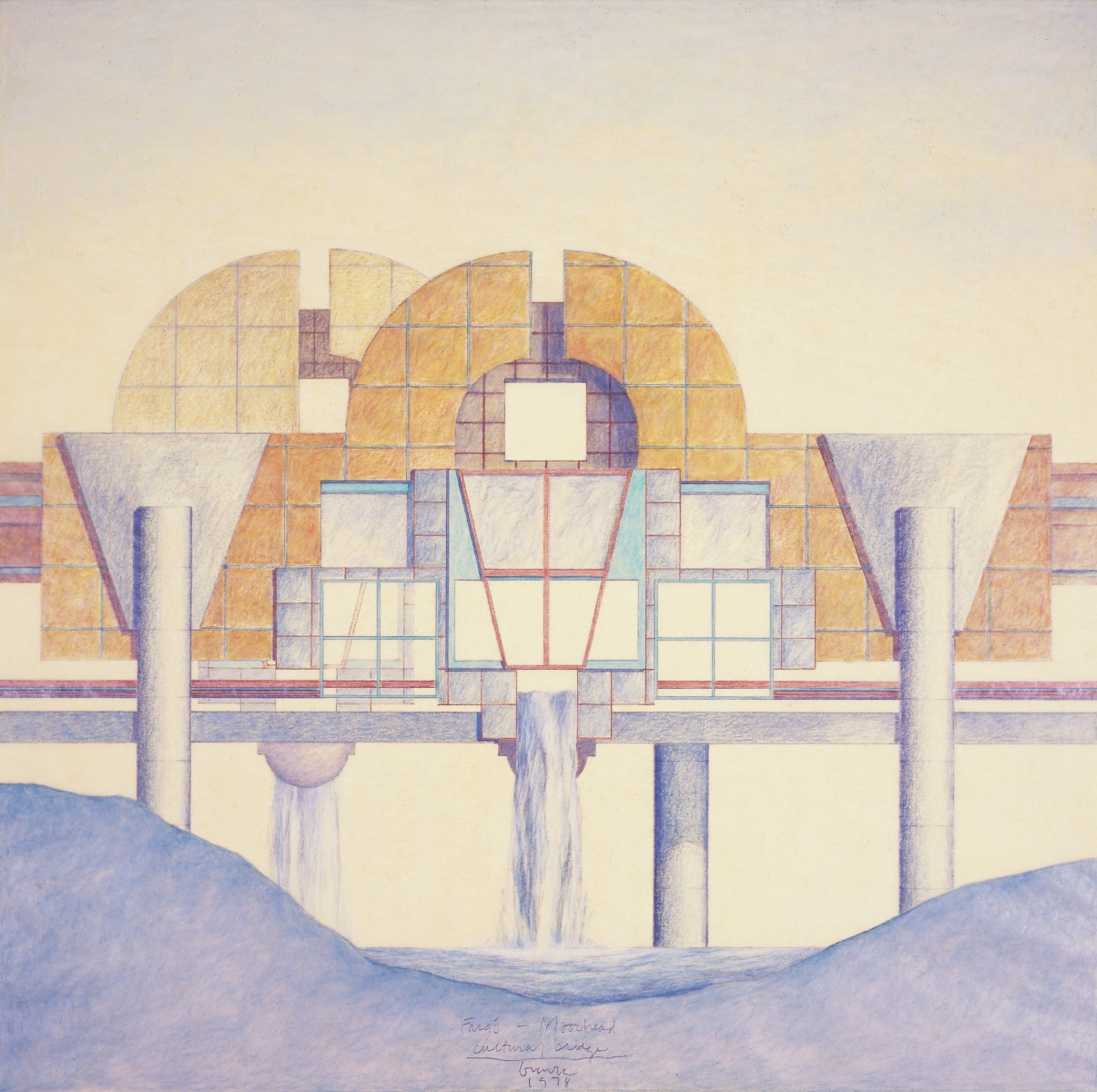
The design for the Fargo-Moorhead Cultural Center Bridge (1977) marks a shifting point in Graves’ architectural career, when he begins to fuse abstraction and neoclassicism into a striking synthesis.
Courtesy Michael Graves Architecture & Design
I joined the office in 1977, a year after I met Michael, right as he had just won the Fargo-Moorhead Cultural Center Bridge commission. It was a critical time for him because he had heard criticism from commentators and historians like Charles Jencks about his architectural language being abstract to the point of alienating people because it needed to be explained. With Fargo-Moorhead and also the Plocek House, which we were working on at the same time, he came to an important realization: In order to make his architecture more intuitive and relatable for a broader audience, he needed to make it figurative enough to let them in—and abstract from there.
The impetus behind this development toward a “figurative architecture” was to give the spectator or passerby the opportunity to empathize with the world of buildings and objects around them. We would have very long conversations about the shape of a door or a window—that’s how vital this idea became for us. You could see it in Michael’s drawings, where he sketched out various elements of architecture such as arches, vaults, or keystones in an iterative way. They would begin as very geometric before gradually growing more and more figural.
But more than that, drawing—and making things—was something that brought us together as a practice. When the Portland Building was under construction, the staff compiled a collection of Michael’s collages that we sold to fund a trip to Portland for the entire office. We wanted to celebrate something we had done together, and Michael was very supportive in building that sense of camaraderie and artistic spirit. all this formed the foundation for what we do, and who we are.
Karen Nichols is a principal at Michael Graves Architecture & Design. From 1977, she worked closely with Graves on his most well-known architectural projects, including the renovation and expansion of the Newark Museum and the unbuilt Whitney expansion.

Graves and associates Barry Richards (left) and Donald Strum (center) inspect prototypes for Alessi, 1993.
Courtesy Donald Strum
I came to the office through nepotism. My architect sister had been working with Michael in the early 1980s when a position opened up in the firm. Basically, anything that needed to be done, I’d do. At the time, I was in my last year at the Parsons School of Design. A month before graduation, Michael called me and another colleague into his office to talk about a commission he had just received from Alessi to do an “American kettle,” which he expressed some puzzlement about. “I don’t really know what it means to do an ‘American kettle,’ but I know we need to do something that boils water fast,” he told us. He asked me to stay the summer to work on it, and so I canceled the cross-country bike ride I had planned.
There was me, this young kid sort of toying around, being asked to work on what would become an incredibly iconic design object. I was very excited and eagerly followed Michael’s lead, modeling his sketches and turning them into three dimensions. Of course, it wasn’t that simple, but Michael made it easy. When he drew a line, it was pure expression, and Michael captured everything about the tea kettle’s design very early on.
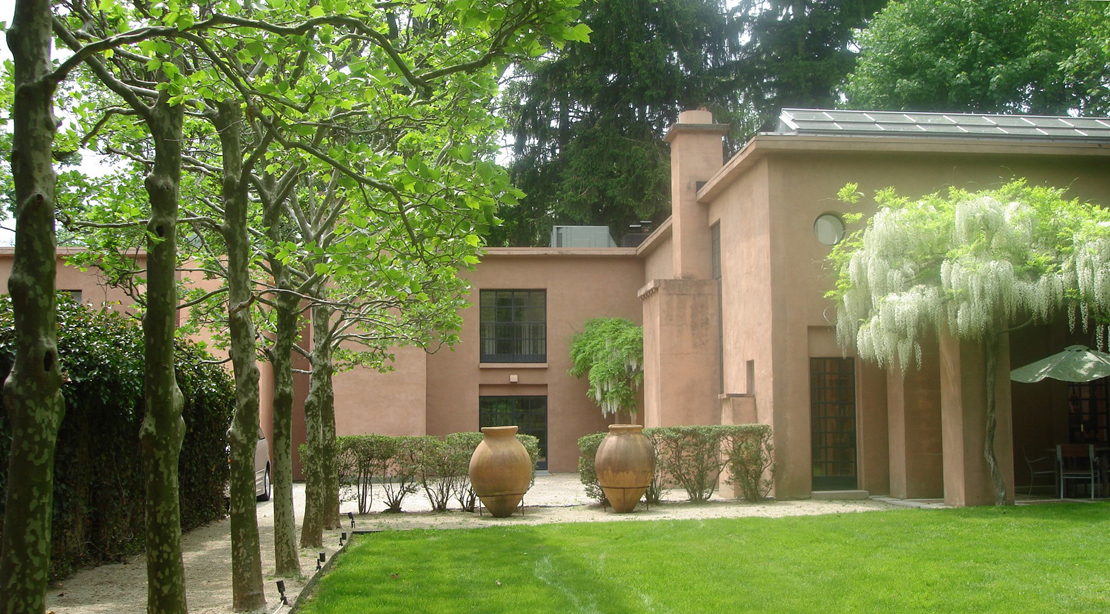
In 1974, Graves purchased an old Princeton storage facility and spent the following decade renovating the property into an Italianate villa. The home, which Graves renovated again after he became paralyzed from the waist down in 2003, was undoubtedly the most idiosyncratic of his 350-plus built projects—a kind of laboratory of living that fused painting, statuary, and Graves’ own domestic products.
Courtesy Michael Graves & Associates
Sometime after, Alberto Alessi arrived in Princeton with his entourage. We gathered in the library of Michael’s house, and they set this black velvet satchel onto the table. Alberto then pulled it off to reveal this beautiful thing, and, after a few minutes of silence, Michael finally spoke up: “Dio mio,” he said in an almost angelic way.
Decades later, after we had done hundreds of products for Target, Michael retained that kind of awe. I remember bumping into him several times at the Princeton Target on Sunday nights, when the store had been completely shopped through. I would find him either straightening shelves of his products, or he would find me. We would stand there in the aisle looking fondly at our products, commenting on them, always rearranging them, and talking about what we could do next.
Donald Strum is principal of product design at Michael Graves Architecture & Design. He has been instrumental in developing the firm’s brand partnerships with Alessi, Target, and more.
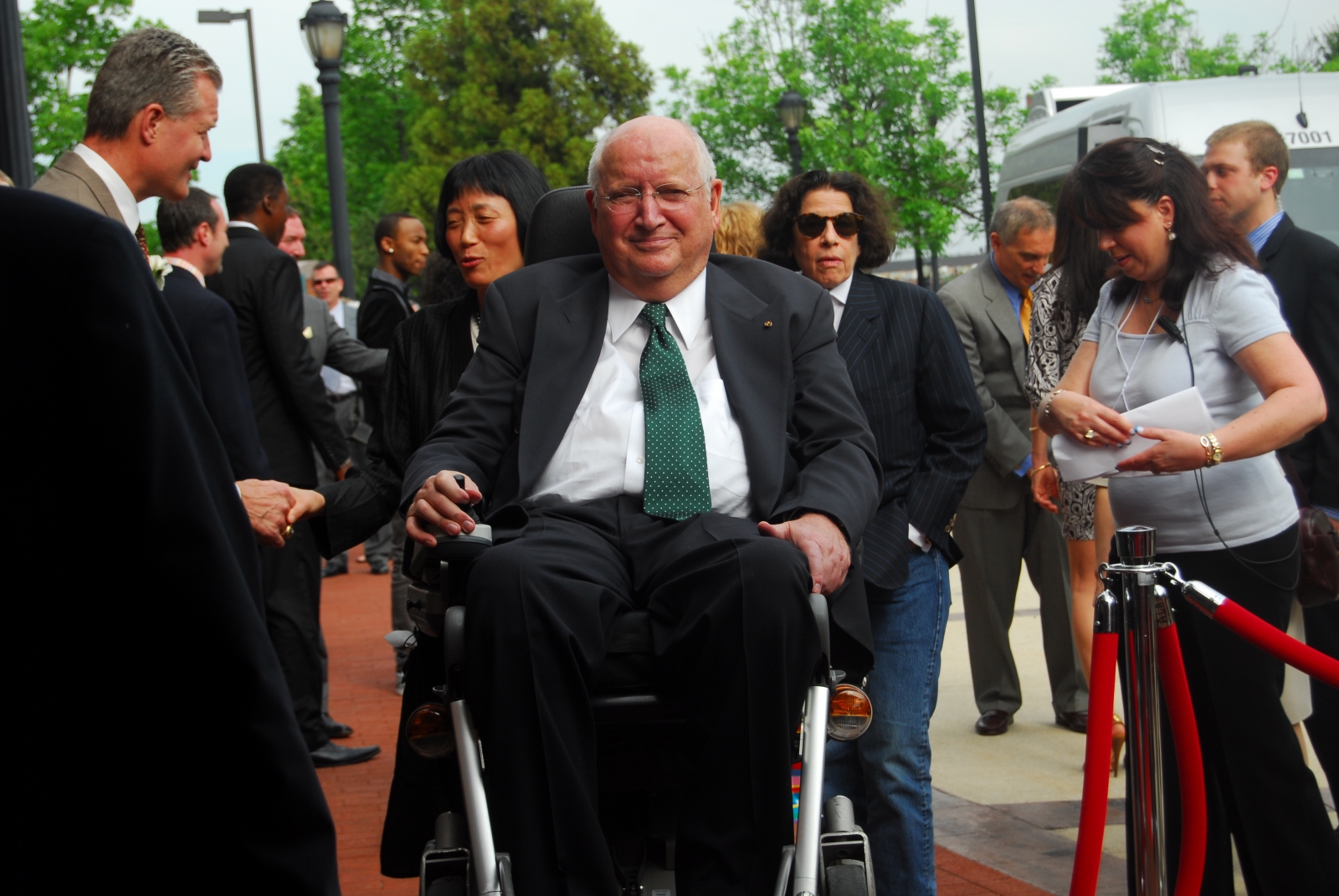
Michael Graves at the New Jersey Hall of Fame in 2010. Fran Lebowitz, Graves’ longtime friend, stands behind him.
Courtesy Gary Gellman/Gellman Images
Ours was an instant friendship. It happens sometimes, not frequently. later, he became my landlord. I was living at the Osborne on 57th Street, one of the oldest apartment buildings in New York, and it was always falling down and needed to be built back up. I was always fleeing in terror because it was incredibly noisy. One summer they were putting on a new roof, and I wanted to get work done, but I couldn’t do it. Michael found me an apartment in Princeton, and sometime after, I rented a house he owned—the one that is in front of the house he lived in.
It was there that I wrote a children’s book that was eventually published in 1994. Michael’s girlfriend at the time said to me, “You know, Michael is very hurt that you didn’t ask him to do the drawings for your book. Why didn’t you?” and I said, “Because it never occurred to me that he had time!” I’ve known a lot of hard workers in my life—and I’m not one of them—but he just worked around the clock. I would see him Sunday afternoon, and then I would see him Wednesday, and in the interim he had been to Hong Kong. Meanwhile, I had been to the supermarket. He was a very hard worker, and lots of hard workers don’t do very good work. But that wasn’t the case with Michael.
Even though he was a very sophisticated, cultivated man, Michael retained a kind of midwestern quality. Not a naivete, but a lack of snobbery. I mean, his favorite food was Peeps—not favorite candy, but favorite food. Of course he had his usual professional snobberies (I, myself, have many), but there was still something nicer about him. Michael didn’t have contempt, which is a quality very common in architects.
Fran Lebowitz is a writer and social commentator. A longtime personal friend of Graves, she collaborated with him on the children’s book Mr. Chas & Lisa Sue Meet the Pandas. In 2010, she introduced Graves at his induction ceremony at the New Jersey Hall of Fame.
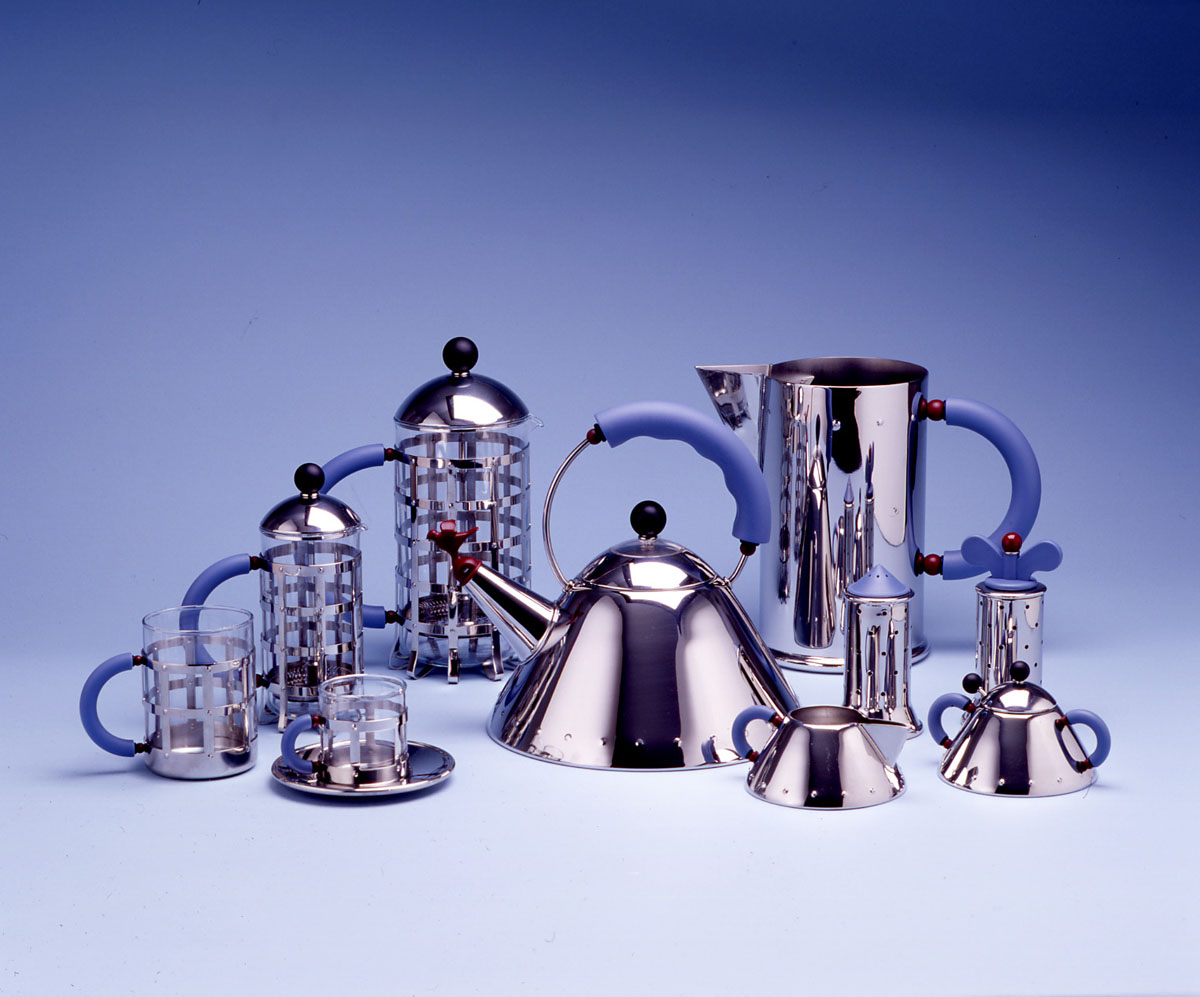
The Michael Graves housewares collection for Alessi (1985).
Courtesy Michael Graves School of Architecture & Design
In January 1980, I traveled with Alessandro Mendini to Princeton to visit Michael as part of our research for what became the “Tea & Coffee Piazza” project. We visited his new home, which he was finishing around that time. It was like entering a Pompeian villa. Michael was proud of the water basin that had come from a Le Corbusier building. And how can I forget his “man purse” that he carried with him? Creased and lived in, it was a meaningful clue to his personality. I was surprised at how busy he was with some big architecture projects. Nevertheless, he told us that from that moment on, he planned to devote half of his time to product design. I saw this as a good opportunity to propose the collaboration with Alessi.
I last saw Michael in Philadelphia, where we had been talking about our new collaboration for 2015, the “Tea Rex Kettle.” He was very energetic. Graves had been our design hero during the 1980s and 1990s because he was able to tune in to the tastes of the public. This is his contribution to twentieth–century design history, the clarity of “popular taste” in high-end industrial design.
Alberto Alessi is president of Alessi Spa and head of the company’s marketing strategy, communications, and design management. He initiated Alessi’s decades-long partnership with Graves.

Graves’ design for a telephone was among the most memorable products launched as part of the first Michael Graves Design Collection for Target in January 1999.
Courtesy Michael Graves Architecture & Design
I had wanted to work with Michael before we were ever introduced and I had traveled to Europe several times and saw how good design generally equaled high-end luxury products. At the time, I was an executive at Target and thought, why not bring this kind of design to middle America, but make it affordable? When I did meet Michael, in Minneapolis, in 1999, and shared the idea with him, he immediately supported it, noting his frustration about how most of his designs were out of reach, price wise, for his Princeton students.
I remember early on in our partnership when we spent two days walking the halls of the Frankfurt Ambiente trade show. It was so energizing, talking the whole time about what we could do—Michael with Target and Target with Michael. At the end of the second day on the bus ride back to our hotel, I asked Michael if he enjoyed the show as much as I did. He looked at me and said, “No. I would have preferred to spend two days in my hotel room imagining what we could create rather than looking at the work of others.” That insight—that great design is born of the imagination—taught me more about design than anything had before. design must be created; it can’t be copied. and at that Michael was a true genius.
Ron Johnson is an executive who masterminded the Michael Graves Design Collection for Target. Johnson, who has worked for Apple and JCPenney, is now founder and CEO of Enjoy.
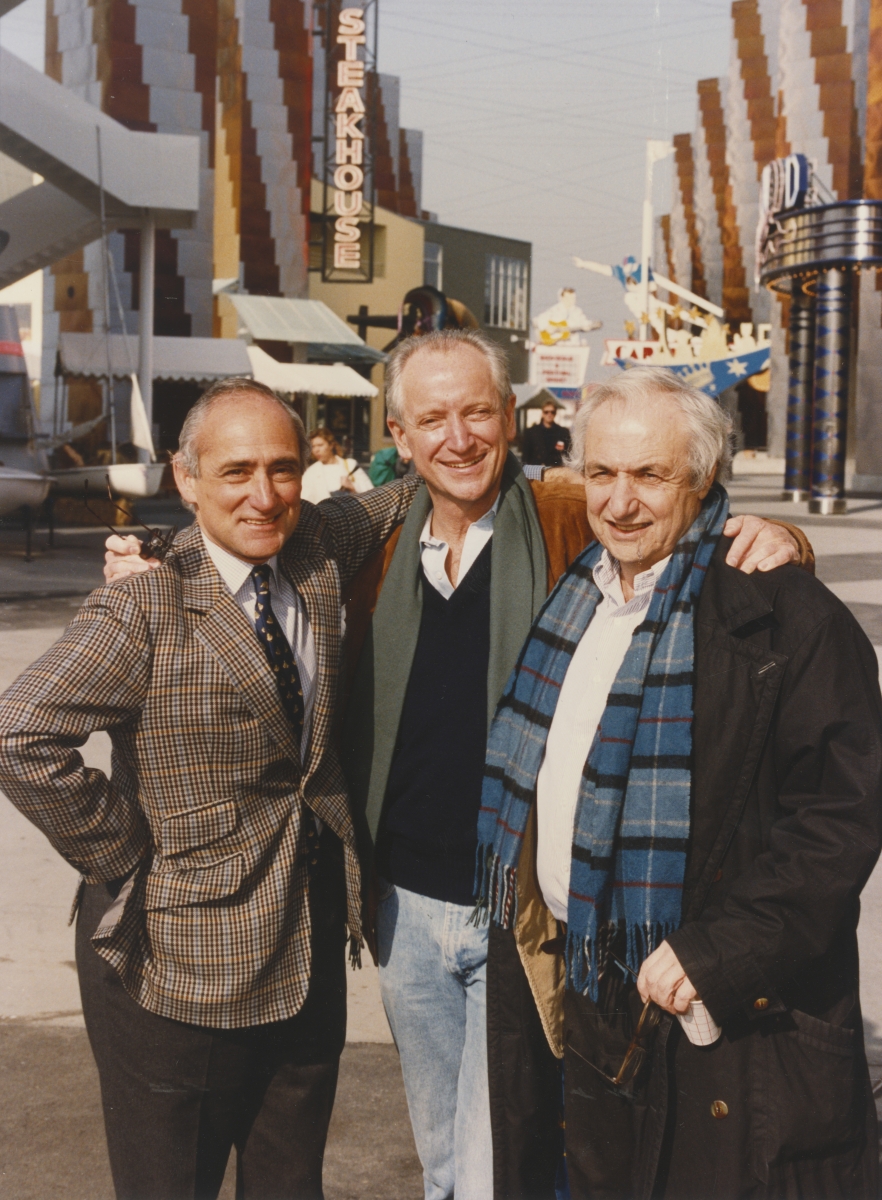
Robert A.M. Stern (left), Graves (center), and Frank Gehry, pose at Disneyland Paris in 1992. Together with Stanley Tigerman and Robert Venturi, the architects developed the schematic plan for the Disneyland Paris parkland.
Courtesy the Walt Disney Company
I got to really know Michael after what you might call his “Saul-Paul conversion,” when he began to change his style and look more carefully at the broader traditions of architecture. In the late 1980s, Michael and I were both doing work for the Walt Disney Company, and so we saw each other fairly often. He did marvelous work for Disney, and I had also done projects for them, while serving on the company board. We talked a lot then, and there were plenty of delicious opportunities to gossip about other architects, who shall be nameless. I’m a pretty witty guy, if I must say so, but Michael had a really caustic wit, and he could come out with amazing zingers—amazing.
Of course, Michael was one of the leading lights of the international Postmodern movement. He was a great leader and the capstone of the movement in a way. He didn’t write a lot of things, but when he did, he wrote most beautifully and intelligently. He was very heroic when that terrible affliction hit him, and he took to his wheelchair. His bright spirit endured, and, in fact, he was nicer. He realized how lucky he was to be alive, and we all realized how lucky we were that he was.
But mostly Michael was a great artist-architect—one of the best of his generation. There aren’t so many of those around, nor is there another one coming down the track behind him that I see. Maybe my vision is blurred, but I don’t think so.
Robert A.M. Stern is founder and senior partner of Robert A.M. Stern Architects and dean of the Yale School of architecture. Alongside Graves, he has designed several buildings for the Walt Disney Company.
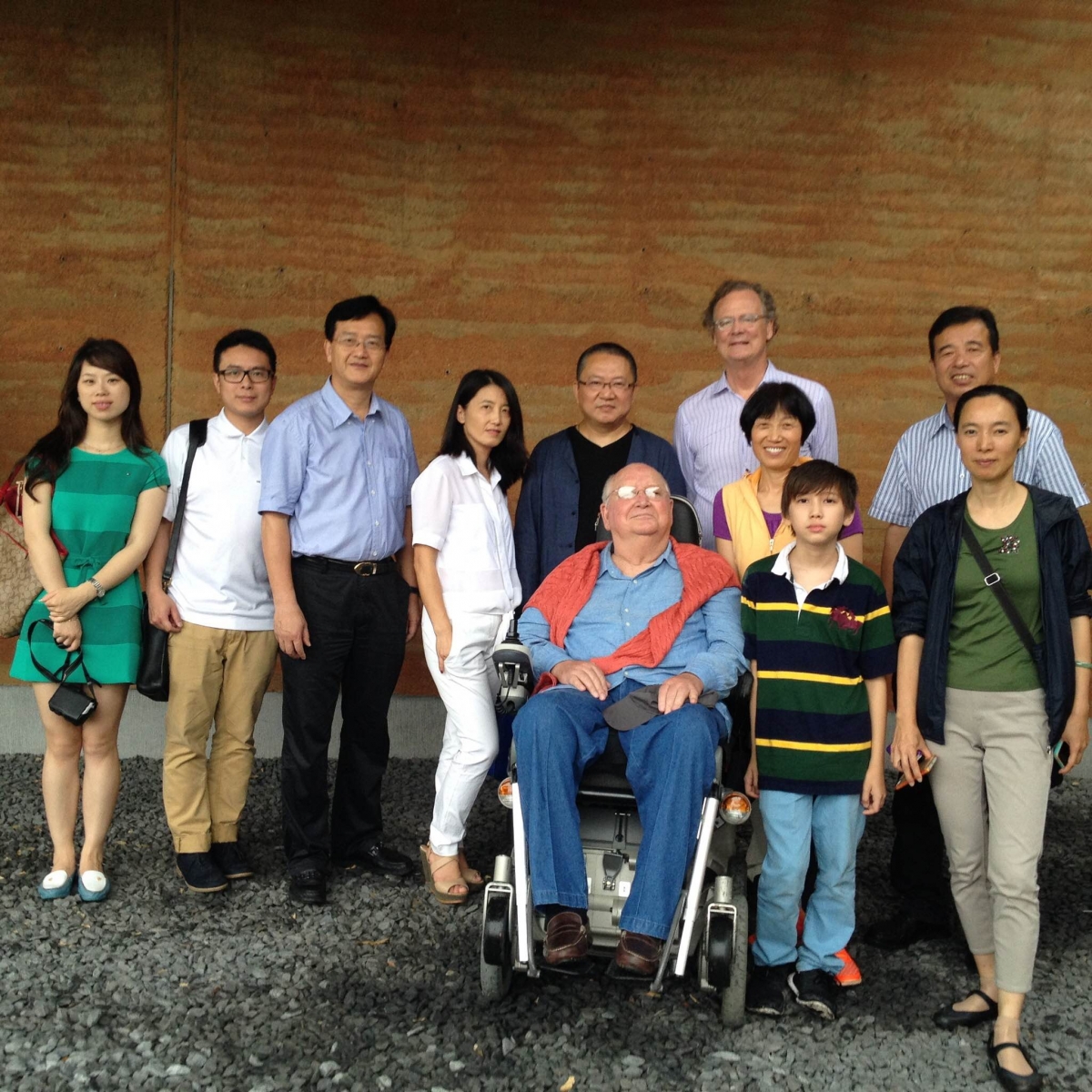
During the summer of 2014, Graves traveled to Wenzhou, China, to visit the proposed site for the newly founded Michael Graves School of Architecture. Together with David Mohney (center right), the school’s acting dean, and his companion and son (pictured to Graves’ left), Graves also traveled to Hangzhou to visit the China Academy of Art, whose buildings had been designed by the architect and Pritzker laureate Wang Shu (center, behind Graves).
Courtesy David Mohney
Michael did a lot of projects at a lot of different scales—hundreds of architecture projects, thousands of furniture pieces and products, and who knows how many paintings. I think what gets overlooked in all of that productivity is how much teaching was every bit the equal of practice to Michael Graves. He was my teacher at Princeton in the late 1970s, and we reconnected five years ago when I moderated a debate between Peter Eisenman and Michael. We had such a good time we decided we should make a book together, which required years of interviews with the two of them, both together and separate.
From these conversations, Michael got to really know me, and a year ago he asked me if I could get involved with the new school of architecture at Kean University, which was named in his honor and whose advisory board he chaired. That summer, we traveled to Wenzhou, China, where the school’s second campus is based. On the last leg of the trip, we went to Hangzhou to meet with Wang Shu, the Pritzker laureate who designed the campus for the Academy of Art there. Wang showed us the school’s most recent building, which is thoroughly modern, with minimal detailing and a giant undulating roof and a perforated facade—basically, the opposite of Michael’s work. But after three or so minutes, Michael turned to me and said, “This is a wonderful work of architecture.”
It wasn’t about style, it was about something being good and of having quality and values. Michael’s appreciation for that building—for all honestly good buildings—made it clear how strongly he was committed to not just teaching an aesthetic or style, but to teaching better architecture.
David Mohney is acting dean of the Michael Graves School of Architecture at Kean University in Union, New Jersey. Mohney is preparing a book on the early professional and academic collaborations between Graves and Peter Eisenman.

Graves (pictured second from right) at a conference in 1979. Left to right: Stanley Tigerman, Robert A.M. Stern, Cesar Pelli, Richard Meier, Charles Gwathmey, Graves, and Peter Eisenman.
Courtesy Richard Meier & Partners Architects archive
I was introduced to Michael in 1962 by a mutual friend who was working in the office of George Nelson. She said to me, “There’s someone working here who I think you’d really like to meet.” We struck up a friendship very quickly, probably because we were both architects who painted. We did a competition together that we worked on in Nelson’s office. after that, we rented a studio on 10th Street, in what was the Tanager Gallery, where we painted after work and on weekends. Michael did wonderful paintings with a palette knife, and I did large abstract expressionist paintings. Willem de Kooning’s studio was next door, and one day he walked by and poked his nose in. I looked at him and back at what I was doing and thought, “I better stick to architecture.”
Michael and I also taught together. It was the mid-1960s, and I would travel down to Princeton for class and, after, dinner with Michael. When he came up to New York, we’d get together to talk. It was all very usual for a close friendship that lasted more than 50 years.
Just the week before he died, on March 3, I was sitting next to Michael at the American Academy of Arts and Letters, where we had a meeting to decide on this year’s awards. He was unusually quiet, but engaged nonetheless. Then he passed away. It’s amazing and very sad. But it was nice to see him get the kind of appreciation he did in the last few months of his life.
Richard Meier is managing partner of Richard Meier & Partners Architects. In the early 1970s, he was a member of the so-called New York Five, along with Graves, Eisenman, John Hejduk, and Charles Gwathmey.
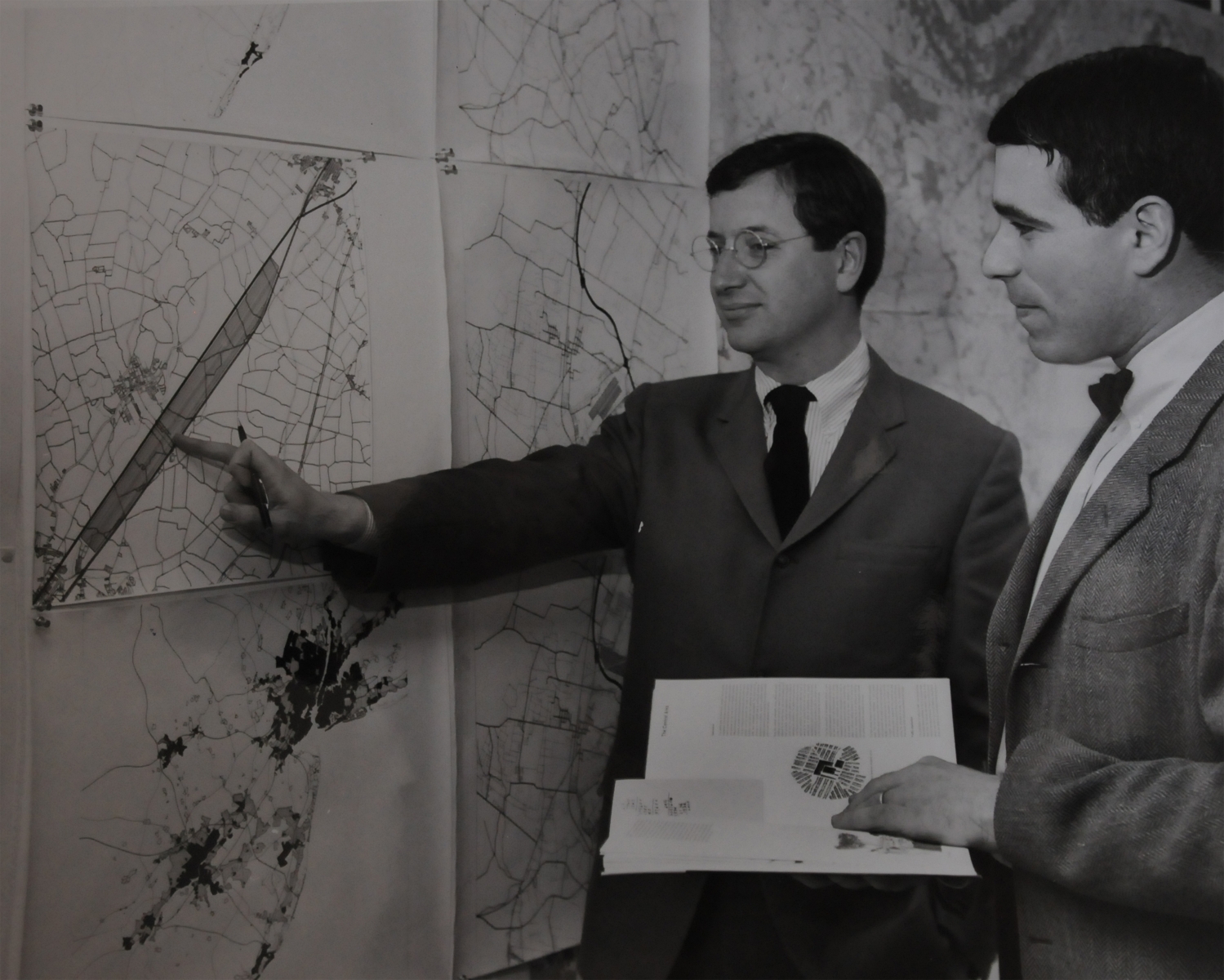
Graves and Peter Eisenman unveil plans for their joint project, the New Jersey Corridor, in 1965. The press, having gotten wind of the radical proposal to build a 20-mile linear city along the Turnpike, erroneously conflate both architects into the single entity Eisenman Graves.
Courtesy David Mohney
Michael Graves lived a heroic life. Today, when “starchitects” are denigrated openly—not only in the media, but also, absurdly, in the profession—to be called a hero is to receive a badge of courage. every discipline needs heroes—film, sport, literature, music, science, even architecture. When I was a student, I needed heroes to learn from. and today, my students need heroes. Often, heroes are lonely figures who challenge accepted norms of behavior by what they say and do. Think of Frank Lloyd Wright or Louis Kahn. Or Michael Graves.
I first met Michael at Harvard in 1959, and joined him at Princeton in 1963 to teach. We spent many an evening drawing on the same boards for competitions, I on plans and he, drawing upside down, on elevations. We did projects like the Jersey Corridor together, and also started the CASE (Conference of Architects for the Study of the Environment) meetings, which later led to the book Five Architects that Paul Goldberger dubbed “The New York Five.”

The more humanistic ideas behind the Jersey Corridor project were conveyed in a series of pastel drawings by Graves, in which he uses a Corbusian sketching style to signal the speculative city’s virtues of greenery, human-centric scale, and sense of place.
Courtesy Michael Graves Architecture & Design
Back then, Michael was the whitest of the so-called “White”—or modern—architects. When Le Corbusier died, we stayed up all night to mount every page of the Oeuvre Complete on the walls of the school’s gallery, over which we laid two giant Xs of black crepe. Michael was such a Corbusian that he even changed his signature to mimic Le Corbusier’s. He was a straight-line Modernist, albeit with a flair—witness his Benacerraf, Hanselmann, and Snyderman houses.
Then, suddenly, a few years after Five Architects, he produced something radically new: the Fargo-Moorhead Cultural Center Bridge. This was no ordinary Postmodernism in the way architects and critics used the term. This was an originality honed by the authority of the modern. Michael’s unique command of art and architecture allowed him to imagine arches with no keystones and a column made of water.

Graves’ third scheme for the Whitney Museum in New York (1988).
Courtesy Michael Graves Architecture & Design
In 1980, after winning the Portland Building competition, and with the success of the Venice Biennale “La Strada Novissima” exhibition, Michael was king of the hill. Numero Uno on the world stage. But later, after losing the three-year struggle to gain approval for his brilliant and eccentric diptych proposed for the Whitney Museum expansion (1985–1988), Michael’s hegemony, like Postmodernism itself, began to erode. He no longer held architecture’s center stage.
Yet he persisted, in his own way, to turn out more design, big and small, than any architect of our generation, just as he would do again following his debilitating illness in 2003. Michael couldn’t abide students who didn’t take their work seriously. But he was especially generous with those who did, and unlike most other teachers, he could draw every building he taught them. He was a consummate talent, an artist-architect, and a teacher who challenged how we think by how we see. Very few can do that. Very few ever try. Michael did try, and therein is the mark of a hero, a master of the discipline who passed on everything he knew.





